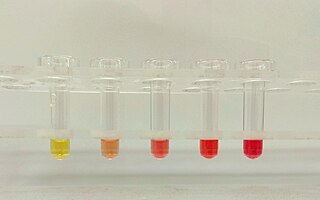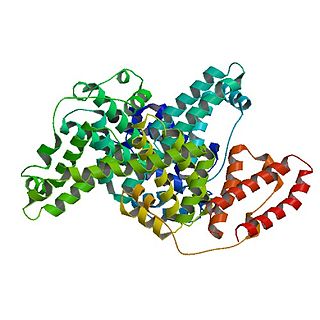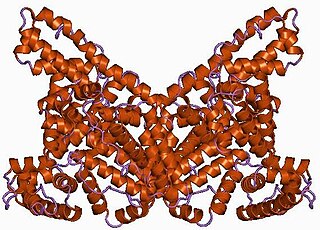Related Research Articles

Hemolysis or haemolysis, also known by several other names, is the rupturing (lysis) of red blood cells (erythrocytes) and the release of their contents (cytoplasm) into surrounding fluid. Hemolysis may occur in vivo or in vitro.

Blood plasma is a light amber-colored liquid component of blood in which blood cells are absent, but which contains proteins and other constituents of whole blood in suspension. It makes up about 55% of the body's total blood volume. It is the intravascular part of extracellular fluid. It is mostly water, and contains important dissolved proteins, glucose, clotting factors, electrolytes, hormones, carbon dioxide, and oxygen. It plays a vital role in an intravascular osmotic effect that keeps electrolyte concentration balanced and protects the body from infection and other blood-related disorders.

Disseminated intravascular coagulation (DIC) is a condition in which blood clots form throughout the body, blocking small blood vessels. Symptoms may include chest pain, shortness of breath, leg pain, problems speaking, or problems moving parts of the body. As clotting factors and platelets are used up, bleeding may occur. This may include blood in the urine, blood in the stool, or bleeding into the skin. Complications may include organ failure.

Fibrinogen is a glycoprotein complex, produced in the liver, that circulates in the blood of all vertebrates. During tissue and vascular injury, it is converted enzymatically by thrombin to fibrin and then to a fibrin-based blood clot. Fibrin clots function primarily to occlude blood vessels to stop bleeding. Fibrin also binds and reduces the activity of thrombin. This activity, sometimes referred to as antithrombin I, limits clotting. Fibrin also mediates blood platelet and endothelial cell spreading, tissue fibroblast proliferation, capillary tube formation, and angiogenesis and thereby promotes revascularization and wound healing.

Haptoglobin is the protein that in humans is encoded by the HP gene. In blood plasma, haptoglobin binds with high affinity to free hemoglobin released from erythrocytes, and thereby inhibits its deleterious oxidative activity. Compared to Hp, hemopexin binds to free heme. The haptoglobin-hemoglobin complex will then be removed by the reticuloendothelial system.

Hemolytic anemia or haemolytic anaemia is a form of anemia due to hemolysis, the abnormal breakdown of red blood cells (RBCs), either in the blood vessels or elsewhere in the human body (extravascular). This most commonly occurs within the spleen, but also can occur in the reticuloendothelial system or mechanically. Hemolytic anemia accounts for 5% of all existing anemias. It has numerous possible consequences, ranging from general symptoms to life-threatening systemic effects. The general classification of hemolytic anemia is either intrinsic or extrinsic. Treatment depends on the type and cause of the hemolytic anemia.

Hypovolemic shock is a form of shock caused by severe hypovolemia. It could be the result of severe dehydration through a variety of mechanisms or blood loss. Hypovolemic shock is a medical emergency; if left untreated, the insufficient blood flow can cause damage to organs, leading to multiple organ failure.

Hemopexin, also known as beta-1B-glycoprotein, is a glycoprotein that in humans is encoded by the HPX gene and belongs to the hemopexin family of proteins. Hemopexin is the plasma protein with the highest binding affinity for heme.
Hypoproteinemia is a condition where there is an abnormally low level of protein in the blood. There are several causes that all result in edema once serum protein levels fall below a certain threshold.

Hypoalbuminemia is a medical sign in which the level of albumin in the blood is low. This can be due to decreased production in the liver, increased loss in the gastrointestinal tract or kidneys, increased use in the body, or abnormal distribution between body compartments. Patients often present with hypoalbuminemia as a result of another disease process such as malnutrition as a result of severe anorexia nervosa, sepsis, cirrhosis in the liver, nephrotic syndrome in the kidneys, or protein-losing enteropathy in the gastrointestinal tract. One of the roles of albumin is being the major driver of oncotic pressure in the bloodstream and the body. Thus, hypoalbuminemia leads to abnormal distributions of fluids within the body and its compartments. As a result, associated symptoms include edema in the lower legs, ascites in the abdomen, and effusions around internal organs. Laboratory tests aimed at assessing liver function diagnose hypoalbuminemia. Once identified, it is a poor prognostic indicator for patients with a variety of different diseases. Yet, it is only treated in very specific indications in patients with cirrhosis and nephrotic syndrome. Treatment instead focuses on the underlying cause of the hypoalbuminemia. Albumin is an acute negative phase respondent and not a reliable indicator of nutrition status.

Bovine serum albumin is a serum albumin protein derived from cows. It is often used as a protein concentration standard in lab experiments.

Human serum albumin is the serum albumin found in human blood. It is the most abundant protein in human blood plasma; it constitutes about half of serum protein. It is produced in the liver. It is soluble in water, and it is monomeric.

Albumin is a family of globular proteins, the most common of which are the serum albumins. All of the proteins of the albumin family are water-soluble, moderately soluble in concentrated salt solutions, and experience heat denaturation. Albumins are commonly found in blood plasma and differ from other blood proteins in that they are not glycosylated. Substances containing albumins are called albuminoids.
Plasma protein binding refers to the degree to which medications attach to blood proteins within the blood plasma. A drug's efficacy may be affected by the degree to which it binds. The less bound a drug is, the more efficiently it can traverse or diffuse through cell membranes. Common blood proteins that drugs bind to are human serum albumin, lipoprotein, glycoprotein, and α, β‚ and γ globulins.
The Cohn process, developed by Edwin J. Cohn, is a series of purification steps with the purpose of extracting albumin from blood plasma. The process is based on the differential solubility of albumin and other plasma proteins based on pH, ethanol concentration, temperature, ionic strength, and protein concentration. Albumin has the highest solubility and lowest isoelectric point of all the major plasma proteins. This makes it the final product to be precipitated, or separated from its solution in a solid form. Albumin was an excellent substitute for human plasma in World War Two. When administered to wounded soldiers or other patients with blood loss, it helped expand the volume of blood and led to speedier recovery. Cohn's method was gentle enough that isolated albumin protein retained its biological activity.
Pentastarch is a subgroup of hydroxyethyl starch, with five hydroxyethyl groups out of each 11 hydroxyls, giving it approximately 50% hydroxyethylation. This compares with tetrastarch at 40% and hetastarch at 70% hydroxyethylation, respectively.

CSL Behring is a biopharmaceutical company, manufacturing plasma-derived, and recombination therapeutic products. The company is a combination of Behringwerke, founded in 1904 in Marburg, Germany by Emil von Behring, and the Commonwealth Serum Laboratories (CSL), established in Australia in 1916 to provide vaccines to the people of Australia, as well as other companies acquired since 2004
A liver support system or diachysis is a type of therapeutic device to assist in performing the functions of the liver. Such systems focus either on removing the accumulating toxins, or providing additional replacement of the metabolic functions of the liver through the inclusion of hepatocytes to the device. This system is in trial to help people with acute liver failure (ALF) or acute-on-chronic liver failure.
Intravascular hemolysis describes hemolysis that happens mainly inside the vasculature. As a result, the contents of the red blood cell are released into the general circulation, leading to hemoglobinemia and increasing the risk of ensuing hyperbilirubinemia.
Methaemalbuminaemia is a clinical condition that can be caused by severe intravascular haemolysis or acute haemorrhagic pancreatitis. This can be due to proteolytic breakdown of haemoglobin to form both haem and methaem. Methaem combines with blood plasma albumin to form methemalbumin which is found in trace amount in the blood. Bleeding into the abdominal cavity is another known cause of methaemalbuminaemia. Methaemalbumin in blood is detected by carrying out a test known as Schumm test which is a spectroscopic identification on addition of ammonium sulphide.
References
- ↑ Methemalbumin at the U.S. National Library of Medicine Medical Subject Headings (MeSH)
- ↑ Myara I, Myara A, Drupt F, Moatti N, Trivin F (September 1988). "Methemalbumin interference in various biochemical assays of plasma". Clin. Chem. 34 (9): 1919–20. doi: 10.1093/clinchem/34.9.1919 . PMID 3416455.